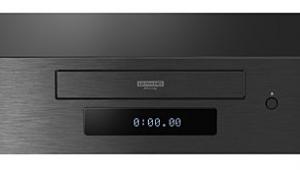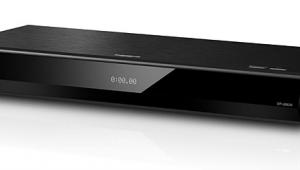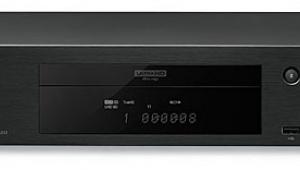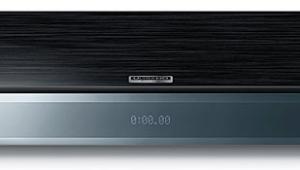Panasonic DMP-BD35 and DMP-BD55 Blu-ray Players
 Price: $299, $399 At A Glance: Full complement of onboard audio decoding • Exceptional video processing • Bonus View and BD-Live compliant • Plays back DVD at 1080p/24
Price: $299, $399 At A Glance: Full complement of onboard audio decoding • Exceptional video processing • Bonus View and BD-Live compliant • Plays back DVD at 1080p/24
Hot on the heels of the DMP-BD50 (HT, September 2008), Panasonic has debuted two new players, the DMP-BD35 and DMP-BD55. Despite the DMP-BD50’s recent release, these two players replace the current DMP-BD30 and DMP-BD50 models. These new players are identical except for their analog audio outputs. The DMP-BD35 only has a two-channel analog output, while the more expensive DMP-BD55 supports 7.1 channels of analog audio. All the other features are the same, so for this roundup, I’ll fuse these two players together in regards to performance unless otherwise noted.

Panasonic slimmed down its players this time around, and the new lineup reminded me a bit of the Sony BDP-S350 in form and stature. The chassis is slightly shorter than the last generation and isn’t quite as deep. The disc tray is now located in the center, and there’s a small flip-down panel on the bottom right with Play, Stop, and Pause buttons, along with the SD card slot. Aesthetically, the new player has the same design cues as the previous line, with a tinted front-display readout and a hidden disc tray. It still retains that bright blue LED right below the tray, but you can turn it off through the Setup menu’s display options.
As I mentioned earlier, the only difference you’ll find with these players is with their back panels. The DMP-BD55 features a 5.1 analog audio connection that you can couple with a separate stereo output for full 7.1-channel analog output. The DMP-BD35 is limited to two-channel on the analog audio side. Both players support HDMI 1.3a, with Deep Color (should the latter appear in the consumer marketplace). Component, S-video, and composite video connections are included, along with TosLink and digital coaxial audio connections.


Both players are BD-Live compatible and have a LAN connection, which lets you link up the player to your home network so you can download Blu-ray features and firmware updates. Please note that Panasonic still requires you to purchase an SD card to meet the BD-Live requirement of 1 gigabyte of “local storage.” While SD cards are quite cheap, I’m disappointed that Panasonic didn’t include onboard memory to meet the minimum spec or at least supply a card with the player. Uninitiated consumers may scratch their heads when the latest BD-Live disc doesn’t work. I also wish that manufacturers would start considering wireless Internet support. Many consumers don’t have LAN connections near their gear, and wireless networks in the home have become very common.
 Panasonic has made some headway with its transport speed. These new players power up and load a bit faster than Panasonic’s last generation of players, even if they still come up a bit short compared with the lightning-quick Sony PS3. Some of the more intensive BD-Java titles, like Ratatouille and Cars take a little bit of patience, but their load times weren’t nearly as objectionable as most standalone Blu-ray players.
Panasonic has made some headway with its transport speed. These new players power up and load a bit faster than Panasonic’s last generation of players, even if they still come up a bit short compared with the lightning-quick Sony PS3. Some of the more intensive BD-Java titles, like Ratatouille and Cars take a little bit of patience, but their load times weren’t nearly as objectionable as most standalone Blu-ray players.
Setting up the player was fairly simple. Panasonic hasn’t changed their setup menus or overall operation since the last generation. These players support video resolutions up to 1080p/24 for Blu-ray playback via HDMI and 1080i/60 for Blu-ray via component. They also support DVD upconversion to 1080p/24 via HDMI. On the audio side, they support both bitstream output and full internal decoding of Dolby TrueHD and DTS-HD Master Audio lossless. The DMP-BD35 is the cheapest standalone player on the market that offers full audio decoding, and I’m glad we’re seeing this level of flexibility.
Internal decoding is convenient for Bonus View titles since the Picture-in-Picture audio needs to mix with the main soundtrack. This isn’t allowed when an AVR or surround processor does the audio decoding. By decoding internally, the player can mix the soundtracks and output the audio as PCM (or in the case of the DMP-BD55, as multichannel analog), which makes the process seamless. The audio setup menu provides clear options on how you want the player to decode audio. It even separates the options based on the audio format, so you can choose different settings for Dolby and DTS.
Connecting to the Internet was simple. The player automatically set the IP protocol after I connected it to my network. The player can trigger updates from the setup menu, which makes firmware updates simple and easy.
During playback, you can access the display menus, which provide some video tweaking, including progressive modes and audio/video format indicators. Unlike some Blu-ray players, the Panasonic players do not offer a bitrate meter for video or audio. However, they do include a status bar, along with indicators for the audio/video format.
Video Performance
The real surprise from this new generation of players is their video processing performance. The UniPhier is Panasonic’s decoding solution, with onboard video processing for Blu-ray and DVD. Panasonic continues to tweak and refine the UniPhier’s capabilities with each successive iteration. This version is the best yet.
Panasonic did a great job with HD video processing on the DMP-BD50 but fell short with standard-definition DVD playback. Not anymore. These new players did outstanding in our new video processing test set. They support full deinterlacing of high-definition and standard DVD playback with great results. (See page 26 for more info on our video processing tests.) These players have definitely set the bar for video playback performance at these price points, and it will be interesting to see how the competition responds.
The DMP-BD35 and DMP-BD55 did a spectacular job in our video tests. These are the first Panasonic players that pass all of our video processing tests for deinterlacing. The UniPhier also did a great job with our resolution tests. It passed information to the very limits of what’s available from the Blu-ray format in pristine fashion. You would truly be hard-pressed to find better video performance with Blu-ray and DVD playback at any price.
In Use
I used both of these players throughout several weeks during the course of this review. Panasonic continues to be my go-to recommendation for a great standalone package. Both of these players cleared up the main issues I had with the previous designs and offers great video playback and audio performance.
I watched several new Blu-ray titles during this review, including Miami Vice and Transformers. These titles are fairly intensive when it comes to interactivity. Both offer full Bonus View, and Transformers is a BD-Live title. Menu navigation and load times were never an issue. It was a big step up from the majority of the standalones I’ve used so far. Aside from the Samsung BD-P1500, these were the fastest players I’ve used in terms of navigation. BD-Live functionality worked with no problems at all, and I downloaded quite a few extras, including some HD video from John Mayer’s superb Where the Light Is Blu-ray concert release.
Panasonic has included the ability to play back standard DVDs at 1080p/24, which is a rarity for Blu-ray players. For all the people with 1080p/24-capable displays, it’s a bonus to be able to take advantage of removing the judder that’s associated with 3:2 pulldown. You can turn this feature on and off from the display menu while a disc is playing. I tested this out using my Lord of the Rings boxed set, and I was surprised at how well the player performed. Normally, tearing and frame drops are quite evident with frame-rate conversion, but the Panasonic players did quite well. Pans were smooth, and I never noticed any frame drops. The player does take a moment to sync up after a chapter skip, but it was smooth sailng from there.
One of the other cool features this player provides is playback of photos, video, and music from the SD card slot. Panasonic includes an SD card with some demo material already on it, and I was surprised at how easy it was to use this function. When I inserted the card, the player brought up a menu of material on the card, and I simply clicked on the material I wanted to view. The quality of the video was surprisingly good.
Wrapping Up
Overall, these new Panasonics represent my top picks for standalone players on the market today. They get top marks in the feature set and video performance categories. They also offer a great package at a very reasonable price point.
- Log in or register to post comments































































